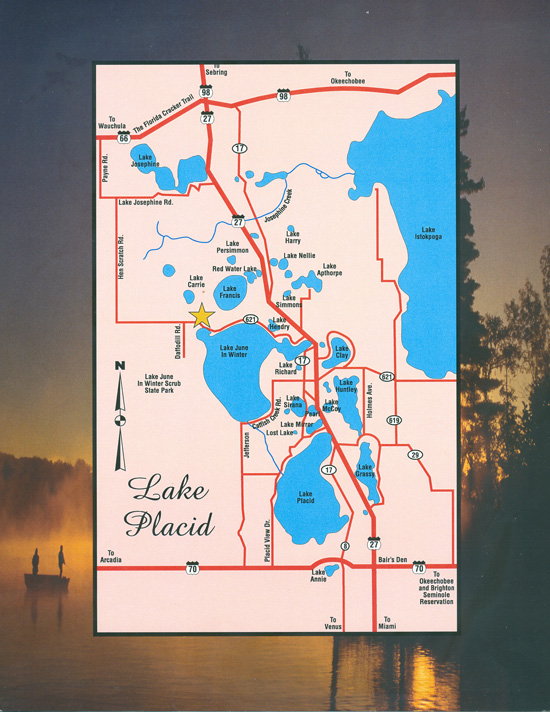History of Lake Placid In the mid-1800s the area now known as Highlands County was inhabited by Seminole Indians. Fish and turtles as well as deer, bear and turkey were plentiful. After the last Seminole War (1856 - 58), the Seminoles retreated to the Everglades . After the Civil War the railroad came to the area. Settlers arrived. A post office was formed. The town of Lake Stearns was named in honor of Marcellus Stearns, U.S. Government Surveyor General at the time. At one time Lake Placid , known then as Lake Stearns , was the largest town in area in the United States . What comprises the present Lake Placid , though sparsely settled, was then the center of population. In the 1920's Dr. Melvil Dewey, creator of the Dewey Decimal System for classifying library books, arrived in the area. Finding the locale remarkably similar to his native Lake Placid , New York , Dr. Dewey had visions of a resort town to surpass that chillier locale. He called the area his winter playground, and spurred development of the community as a resort. In 1 927 by legislative act, the town was renamed Lake Placid . In the early years of its incorporation, lake Placid thrived as a resort town. Main Street was dressed up with beautifully landscaped parkways and picturesque arches. There were several large hotels and lodges, including the Little Loj and Lyvok on Lake Placid (now the Lake Placid Conference Center ), the Peggy O'Neal Lodge, and the Arcade Hotel (in town). The spontaneous growth Dewey expected did not occur, but a steady, more reliable growth did; and the few hundred people in the area in 1928 swelled to the present population of several thousands. With its rolling hills, beautiful lakes and near-perfect climate, it is popular for both vacation and retirement; and with industry becoming aware of the advantages of climate, ample ,labor and a steadily increasing southern market, Lake Placid's future looks very promising. Climate Like much of Florida , our climate is One of our most valuable assets. Not only does our sunshine and mild temperatures, attract visitors and new residents, which adds to our economic base, but our climate is idea for our citrus, caladium and cattle industries. We get gentle breezes off nearby lakes that make the warmer months comfortable. Winter may bring temperatures dip to near freezing but soon climb, presenting |
another warm and sunny day. Average yearly temperatures range from a high of 85.5 degrees to a low of 61.4 degrees. Rain is more than adequate for all needs but never excessive. Economy Our citrus, caladium and cattle industries ensure a flourishing economy for Lake Placid . Many of these businesses are third-generation owned, reflecting a stable economic base. The nature of these agriculture-based industries restricts uncontrolled urban development, helping to keep Lake Placid a desirable place to live. Because of modest land and labor costs, new businesses, both national and international, are drawn to Florida 's Lake Country , providing a rich source of employment in surrounding areas. The many newcomers find employment throughout our county, but choose to live in the more tranquil surroundings of Lake Placid . Education/Schools Four public schools serve ,the Lake .Placid area. Lake Country Elementary Lake Placid Elementary, Lake Placid Middle School , and Lake Placid High School are accredited by the Southern Association of Colleges and Secondary Schools. The public school system is governed by the Highlands County School Board located in Sebring. Five members are elected to serve four-year terms. The high school is housed in a beautiful complex resembling a college campus. Its teams, known as the Green Dragons, compete in football, basketball, baseball, swimming, track, tennis and golf. Lake Placid also has two private Christian schools, Lake Placid Christian School and Lakeview Christian School . We also have Montessori Childrens School of Lake Placid, preschool through kindergarten. 27 Freshwater Lakes Lakes are one of Highlands County 's most attractive natural features. There, is an incredible diversity of lakes in the area that ranges from large deep, clear lakes such as Placid and June-in-Winter to shallower, highly productive lakes such as Apthorpe, Crews and Carrie that support excellent fish populations. Lake Istokpoga , world, renowned for its fishing, also supports resident populations of osprey and bald eagles, as well as many other forms of. wildlife. For more information, log on to: www.lpfla.com. |
|
 |
||
Contact us today for an appointment to meet with us. Copyright © 2001- A.A.M. Industries, Inc. All rights reserved.
With the compliments of PoloCenter.com - 06/06/01 -